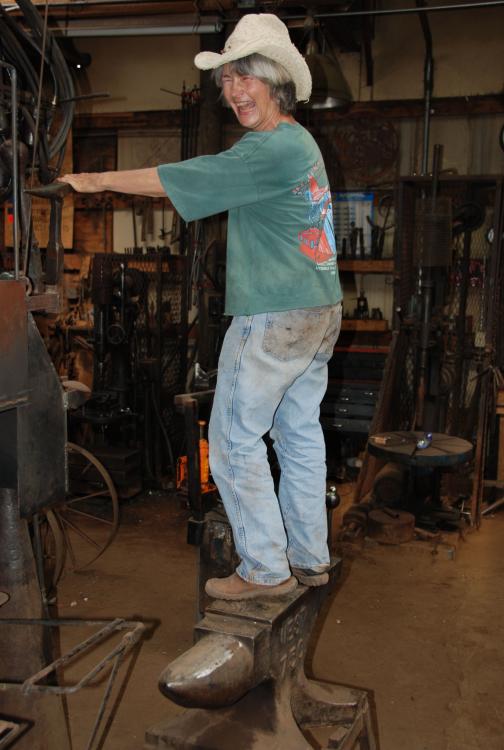-
Posts
689 -
Joined
-
Last visited
Content Type
Profiles
Forums
Articles
Gallery
Downloads
Events
Everything posted by Fatfudd
-

Columbian anvil, worth it?
Fatfudd replied to kiddcaprix's topic in Anvils, Swage Blocks, and Mandrels
Outstanding deal!!! Congratulations. -

Columbian anvil, worth it?
Fatfudd replied to kiddcaprix's topic in Anvils, Swage Blocks, and Mandrels
According to old ads for Colombian anvils and given the dimensions you sited it should weigh around 200lbs. $450 would be a very good deal. If it were me, I would be there grinning with money in hand. -

new to me anvil plz help identafi
Fatfudd replied to Goblin79's topic in Anvils, Swage Blocks, and Mandrels
I don't have that info but the anvil I owned was of the earlier base configuration and the one that Fred owns was of the later base type with the caplet shape.. they would have corresponding serial numbers. The vises were sometimes dated. -

new to me anvil plz help identafi
Fatfudd replied to Goblin79's topic in Anvils, Swage Blocks, and Mandrels
Indian Chief was a trademark of Trenton, They regularly labeled their leg vises and LARGE bridge anvils with the indian chief logo. They occasionally also labeled their regular anvils with the indian chief trademark. I owned one and traded it to Fred Moore who collects anvils and also had one. You can see both of them by looking at the youtube under largest anvil collection. -

new to me anvil plz help identafi
Fatfudd replied to Goblin79's topic in Anvils, Swage Blocks, and Mandrels
Early Boker trenton anvil, looks to be in good condition. That's an outstanding deal! in good condition like yours collectors are paying a premium. They were either made in Germany or England there is some question about the manufacturing location. Some are marked Germany and i have seen one that was marked USA. Maybe if you rub some chalk on the side you'll be able to see more lettering. -

Help determining anvil weight
Fatfudd replied to PeterDE4's topic in Anvils, Swage Blocks, and Mandrels
According to Fisher ads in Postman's book your anvil should weigh around 350lbs.. Also, if you use a knotted wire brush on an angle grinder you won't do any damage to the anvil and you can clean the rust of very easily. -

Help determining anvil weight
Fatfudd replied to PeterDE4's topic in Anvils, Swage Blocks, and Mandrels
My 400 lb fisher is 35" long over all. with similar width dimensions. The 350 lb fisher I used to have was very similar to the one you describe. The dilemma is that there is some variation among the different sizes versus weights of fisher anvils. One question tho does your anvil have lugs on the feet for mounting? -
That anvil was made prior to 1835 since it doesn't have a pritchel hole. It is a very nice old anvil and one that I wouldn't use a 15lb sledge hammer on. If I needed to use a hammer that large I'd try to fine a big thick piece of any kind of steel because rebound won't be a big necessity, You might want to do a search for striking anvils, which is what you need. However since its your anvil you are free to do whatever you want to it.
-

Old unusual anvil, unknown manufacturer and age
Fatfudd replied to starchaser's topic in Anvils, Swage Blocks, and Mandrels
I meant to say the whole top plate is tool steel. Itshould be about 1/2in or 1.5cm thick. The rest is wrought iron usually made by the manufacturer in the process of making the anvil. I'm assuming that most English anvil makers purchased their crucible steel from the "continent" (Sweden?) -
Kevin- You might want to pick up a copy of Anvils in America, it'll give answers to your questions.
-
If I read the serial number correctly the anvil was made about 1926 according to Postman. He also said that around 1927 the entire top half of the anvil was made from tool steel. However looking at that anvil and one that I used to have which was also made with the top half being tool steel and with that heavy weld around the mid-section I'd guess that it was also made with a tool steel top. It looks to be in excellent condition and if I had a chance at it, it would be in my shop!! That is a very good price for an excellent anvil.
-

Old unusual anvil, unknown manufacturer and age
Fatfudd replied to starchaser's topic in Anvils, Swage Blocks, and Mandrels
You are correct, the whole top of the anvil is a tool steel or as it was called back then, a crucible steel top so it should ring and the heel usually does ring louder on most good quality wrought or cast steel anvils. I really can't tell you who might have made your anvil because there were scores of anvil manufacturers in old England. perhaps some of our British IFI members can help with the ID? -

Old unusual anvil, unknown manufacturer and age
Fatfudd replied to starchaser's topic in Anvils, Swage Blocks, and Mandrels
The base/body for older English anvils were typically made in in 7 pieces; the body, the heel, the horn and the 4 feet. The top plate was usually made of several pieces, on smaller anvils such as yours there were 3 plates. All of this was forge welded together. The lines you see under the heel and on the top are probably where the pieces were attached. I believe your anvil is all original and altho the pritchel hole is uncommon I have seen several with that wide face configuration. Maybe when Thomas Powers wades in he can tell us what the purpose of the location of the pritchel was for? Nice anvil! -
I'm afraid i can't agree with njanvilman, I live in a very poor anvil area. I recently purchased the anvil pictured below for our ABANA affiliate for $300. It is a near mint 100lb Brooks cast steel anvil that was listed on craigslist. You may be able to get more for you anvil but its best not to create unfair expectations. if you can get between $3/lb to $4/lb you will be doing very well indeed.
-
-
The anvil resembles an Arm and Hammer anvil because of the distinctive top plate and also the shape and point of the horn. A&H manufactured anvils up to the 1950s. I agree with NJanvilman that the numbers could have been added later. If you can pry the anvil out of the stand see if there are any numbers on the front foot.
-
More pictures would help, but why do you think it has a cast body? It looks like it has a top plate for the face, much like a wrought iron bodied anvil. Some of the later wrought iron anvil's bodies were forged in closed dies which can look somewhat like they were cast because of a parting line.
-

Trying to ID Swedish cast steel anvil
Fatfudd replied to Pat the Newbie's topic in Anvils, Swage Blocks, and Mandrels
all in all you got a very good deal, now get to work and show us what you can make! -
Is there a number under the horn next to the handling hole? it has a Hay Budden type of base.
-
If it has a reasonable rebound and you are just starting out, then use it to learn on and start making money with it. I wouldn't sweat the value as long as it will do what you want. Most of us started out on a piece mild steel or if we were lucky a piece of rail road track.
-
Price or value is strongly influenced by location. Its in OK condition, not great but usable. Here in NM where there aren't a lot of decent anvils you might get $250 for it. In Ohio or locations where avils grow on trees you probably won't get as much. That being said prices have been going up due to the shows on cable TV about knife and gun making. There are many new aspirants to blacksmithing that will pay a lot for any anvil so the best suggestion is to simply advertise it at a price you want to sell it for and see what happens. Best of luck.
-
Also American anvil were well made and the few that I have seen were of good quality,
-
Tarps work and periodic rubbing with boiled linseed oil will help too.
-
Because your anvil has a number on its heel (12) it was made after 1908 and is the 3rd variation of Hay Buddens. Its top half is made out of high quality tool steel and is very desireable. Excellent anvil!

